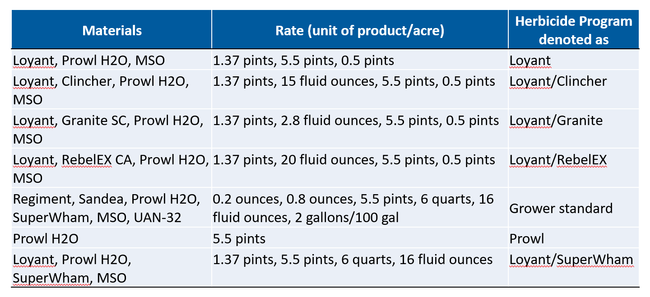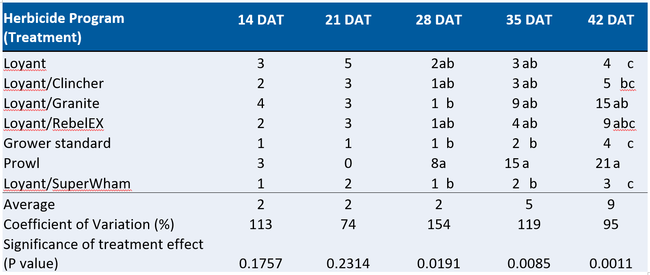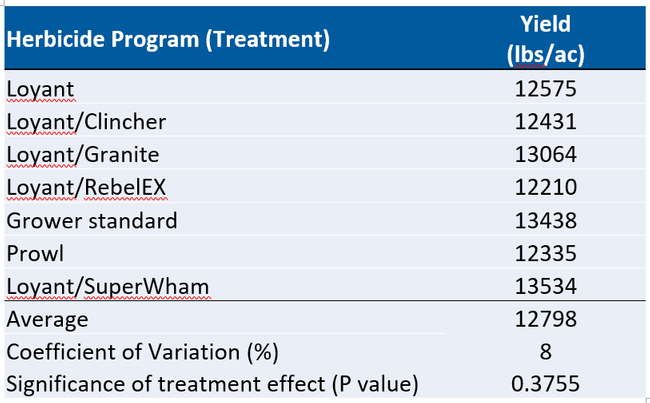Weeds are important pests of California rice systems, and weed management can account for roughly 17 percent of total operating costs (Espino et al., 2016). Integrated weed management uses cultural and chemical practices where herbicide are important tools. Certain conditions in California rice production systems, however, increase the likelihood of developing herbicide resistance. Herbicide resistance is the ability of certain weed biotypes to survive certain herbicide treatments when the weed species is usually killed by that herbicide (Al-Khatib et al., 2019). Such conditions include, but are not limited to, lack of crop rotation, the efficacy of certain herbicides on certain weeds causing them to get frequently used, and not having diverse chemistries available.
In 2019 and 2020, trials were conducted to evaluate the efficacy of a new herbicide product called Loyant (florpyrauxifen-benzyl; group 4 herbicide; Corteva Agriscience) in drill-seeded rice in the Delta region. Loyant is registered in rice growing states in the southern US but would be a new chemistry in California. Corteva Agriscience expects to have CA registration in time for the 2021 use season. The objective of the trials, by assessing different rates and treatment combinations, was to understand the efficacy and crop tolerance of Loyant for weed control in drill-seeded rice in California. This article will describe select results of the 2020 trial. Treatments are listed in Table 1 below. Complete information from both years is available from my website.
Crop injury. We made crop injury observations and weed counts on 7-day intervals for about two months following treatment. We observed tip burning in several of the treatments, but the symptoms were no longer apparent by 21 days after treatment (DAT). We observed leaf curling in the Loyant treatments until about 56 DAT. Corteva Agriscience has observed this symptom with Loyant in other trials where environmental stressors impact crop health, such as extreme cold or heat, drought, or poor fertility. We observed this symptom on the side of the plots closest to the field edge. We observed no stunting, stand reduction, or differences in heading with any treatments.
Weed control. Overall weed pressure was relatively low, observing about 1 weed per square foot in an untreated strip next to the trial. The prominent weeds in the field were Echinochloa species (i.e. watergrass, barnyardgrass; Figure 1, below). We did not have a completely untreated control but instead considered the pre-emergent only treatment (i.e. Prowl) the control. There was a trend for the Prowl treatment to have the highest weed counts. The treatments that had the best weed control were the grower standard and Loyant/SuperWham herbicide programs (Table 2, below).
Yield. We found no differences in yield, but there was a trend for the grower standard and the Loyant/SuperWham herbicide programs to have slightly higher yields (Table 3, below). Measured yields were uncharacteristically high for the region. Our explanation of the data is that we did our hand harvest in the early morning hours when there was a heavy dew. Because variability across the replicates was low, as indicated by the coefficient of variation, we believe the data demonstrate relative comparability of herbicide programs, even though the absolute values are high.
Conclusions. The purpose of the trial was to learn the efficacy and crop tolerance of Loyant (florpyrauxifen-benzyl) for weed control in California drill-seeded rice. We observed Loyant to have good activity on watergrass and barnyardgrass, which were the predominant weeds in the trial. We observed Loyant treatments to have similarly low weed counts compared to the grower standard, and a Loyant/SuperWham herbicide program appears to provide comparable weed control to the grower standard. The results demonstrate that Loyant could be used in drill-seeded rice herbicide programs, providing a different chemistry for herbicide resistance management.
The aforementioned information on products and practices is for educational purposes only and does not constitute an endorsement or recommendation by the University of California.
Table 1. Herbicide treatments in the 2020 trial. Treatments were applied on May 8th, when the rice was approximately at the 3rd leaf stage.
Figure 1. Predominant weeds in the trial were watergrass and barnyardgrass.
Table 2. Weed counts on 7-day intervals from 14 DAT to 42 DAT. Data represent total number of weeds in the 400-ft2 plot and are the means across four replicates.
Table 3. Yield adjusted to 14 percent moisture. The trial was hand-harvested on Sept. 29, measuring one 10.8-ft2 (1-m2) quadrat per plot. The grower reported that harvest moisture was around 18.5 percent.



